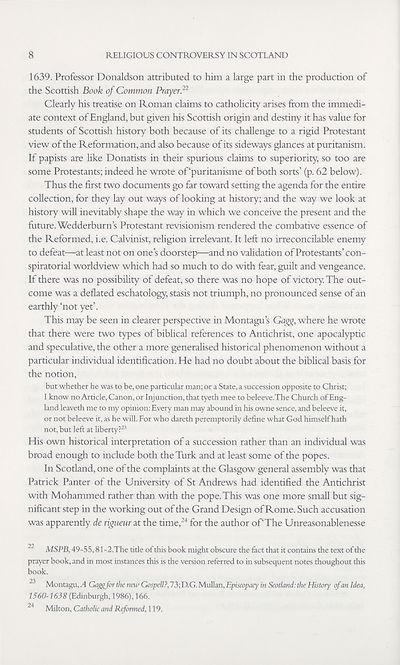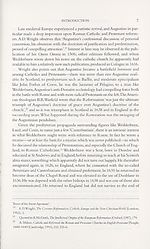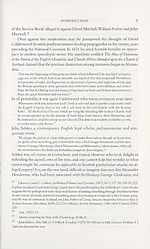Series 5 > Religious Controversy in Scotland 1625-1639
(23) Page 8
Download files
Complete book:
Individual page:
Thumbnail gallery: Grid view | List view

8
RELIGIOUS CONTROVERSY IN SCOTLAND
1639. Professor Donaldson attributed to him a large part in the production of
the Scottish Book of Common Prayer.22
Clearly his treatise on Roman claims to catholicity arises from the immedi¬
ate context of England, but given his Scottish origin and destiny it has value for
students of Scottish history both because of its challenge to a rigid Protestant
view of the Reformation, and also because of its sideways glances at puritanism.
If papists are like Donatists in their spurious claims to superiority, so too are
some Protestants; indeed he wrote oPpuritanisme of both sorts’ (p. 62 below).
Thus the first two documents go far toward setting the agenda for the entire
collection, for they lay out ways of looking at history; and the way we look at
history will inevitably shape the way in which we conceive the present and the
future. Wedderburn’s Protestant revisionism rendered the combative essence of
the Reformed, i.e. Calvinist, refigion irrelevant. It left no irreconcilable enemy
to defeat—at least not on one’s doorstep—and no validation of Protestants’ con¬
spiratorial worldview which had so much to do with fear, guilt and vengeance.
If there was no possibility of defeat, so there was no hope of victory. The out¬
come was a deflated eschatology, stasis not triumph, no pronounced sense of an
earthly ‘not yet’.
This may be seen in clearer perspective in Montagu’s Gagg, where he wrote
that there were two types of biblical references to Antichrist, one apocalyptic
and speculative, the other a more generalised historical phenomenon without a
particular individual identification. He had no doubt about the biblical basis for
the notion,
but whether he was to be, one particular man; or a State, a succession opposite to Christ;
I know no Article, Canon, or Injunction, that tyeth mee to beleeve.The Church of Eng¬
land leaveth me to my opinion: Every man may abound in his owne sence, and beleeve it,
or not beleeve it, as he will. For who dareth peremptorily define what God himself hath
not, but left at liberty?23
His own historical interpretation of a succession rather than an individual was
broad enough to include both the Turk and at least some of the popes.
In Scotland, one of the complaints at the Glasgow general assembly was that
Patrick Panter of the University of St Andrews had identified the Antichrist
with Mohammed rather than with the pope. This was one more small but sig¬
nificant step in the working out of the Grand Design of Rome. Such accusation
was apparendy de rigueur at the time,24 for the author of'The Unreasonablenesse
22 MSPB, 49-55,81-2.The tide of this book might obscure the fact that it contains the text of the
prayer book, and in most instances this is the version referred to in subsequent notes thoughout this
book.
23 Montagu, A Gaggjor the new Gospell?, 73; D.G. Mullan, Episcopacy in Scotland: the History of an Idea,
1560-1638 (Edinburgh, 1986), 166.
24 Milton, Catholic and Reformed, 119.
RELIGIOUS CONTROVERSY IN SCOTLAND
1639. Professor Donaldson attributed to him a large part in the production of
the Scottish Book of Common Prayer.22
Clearly his treatise on Roman claims to catholicity arises from the immedi¬
ate context of England, but given his Scottish origin and destiny it has value for
students of Scottish history both because of its challenge to a rigid Protestant
view of the Reformation, and also because of its sideways glances at puritanism.
If papists are like Donatists in their spurious claims to superiority, so too are
some Protestants; indeed he wrote oPpuritanisme of both sorts’ (p. 62 below).
Thus the first two documents go far toward setting the agenda for the entire
collection, for they lay out ways of looking at history; and the way we look at
history will inevitably shape the way in which we conceive the present and the
future. Wedderburn’s Protestant revisionism rendered the combative essence of
the Reformed, i.e. Calvinist, refigion irrelevant. It left no irreconcilable enemy
to defeat—at least not on one’s doorstep—and no validation of Protestants’ con¬
spiratorial worldview which had so much to do with fear, guilt and vengeance.
If there was no possibility of defeat, so there was no hope of victory. The out¬
come was a deflated eschatology, stasis not triumph, no pronounced sense of an
earthly ‘not yet’.
This may be seen in clearer perspective in Montagu’s Gagg, where he wrote
that there were two types of biblical references to Antichrist, one apocalyptic
and speculative, the other a more generalised historical phenomenon without a
particular individual identification. He had no doubt about the biblical basis for
the notion,
but whether he was to be, one particular man; or a State, a succession opposite to Christ;
I know no Article, Canon, or Injunction, that tyeth mee to beleeve.The Church of Eng¬
land leaveth me to my opinion: Every man may abound in his owne sence, and beleeve it,
or not beleeve it, as he will. For who dareth peremptorily define what God himself hath
not, but left at liberty?23
His own historical interpretation of a succession rather than an individual was
broad enough to include both the Turk and at least some of the popes.
In Scotland, one of the complaints at the Glasgow general assembly was that
Patrick Panter of the University of St Andrews had identified the Antichrist
with Mohammed rather than with the pope. This was one more small but sig¬
nificant step in the working out of the Grand Design of Rome. Such accusation
was apparendy de rigueur at the time,24 for the author of'The Unreasonablenesse
22 MSPB, 49-55,81-2.The tide of this book might obscure the fact that it contains the text of the
prayer book, and in most instances this is the version referred to in subsequent notes thoughout this
book.
23 Montagu, A Gaggjor the new Gospell?, 73; D.G. Mullan, Episcopacy in Scotland: the History of an Idea,
1560-1638 (Edinburgh, 1986), 166.
24 Milton, Catholic and Reformed, 119.
Set display mode to:
![]() Universal Viewer |
Universal Viewer | ![]() Mirador |
Large image | Transcription
Mirador |
Large image | Transcription
Images and transcriptions on this page, including medium image downloads, may be used under the Creative Commons Attribution 4.0 International Licence unless otherwise stated. ![]()
| Scottish History Society volumes > Series 5 > Religious Controversy in Scotland 1625-1639 > (23) Page 8 |
|---|
| Permanent URL | https://digital.nls.uk/127328241 |
|---|
| Description | Over 180 volumes, published by the Scottish History Society, containing original sources on Scotland's history and people. With a wide range of subjects, the books collectively cover all periods from the 12th to 20th centuries, and reflect changing trends in Scottish history. Sources are accompanied by scholarly interpretation, references and bibliographies. Volumes are usually published annually, and more digitised volumes will be added as they become available. |
|---|


